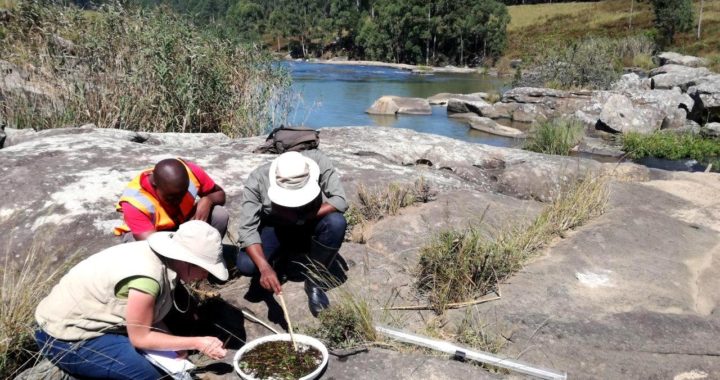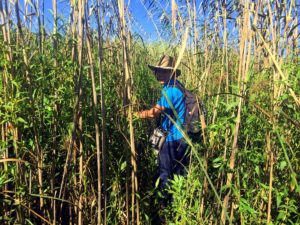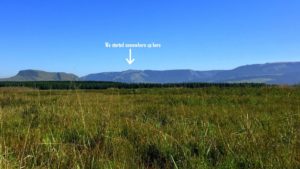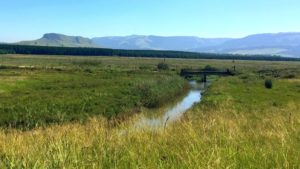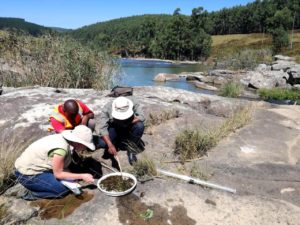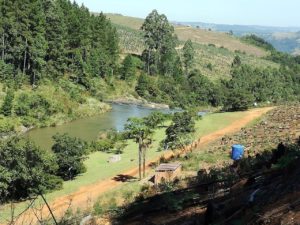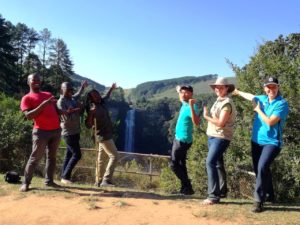On Day 5 of the Catchment to Confluence Karkloof River Walk the team was thrilled to be joined by 2 fresh pairs of legs, Mbuso Khambule (new SAPPI Environmental Officer) and Mondli Goba (SAPPI Communications Officer), just in time to pass through some of the SAPPI Shafton plantation areas on the Karkloof floodplain.
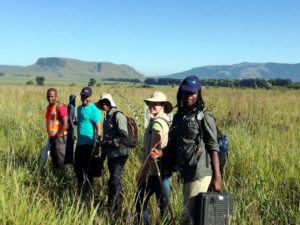
Team setting off. From Left: Nduduzo Khoza (EWT Eco-Ranger), Mondli Goba (Sappi), Mbuso Khambule (Sappi), Twané Clarke (Karkloof Conservancy), Ayanda Lipheyana (GroundTruth) and the photographer behind the camera is Sue Viljoen (WWF-SA)
Our destination for the day was the Karkloof Falls, starting at the pumphouse on Gartmore farm, which as the crow flies did not seem all that far. But we now knew by experience that following the meanders of a river over rough terrain or tall vegetation where there is no path is not likely to be a walk in the park.
As we pushed through the wetland, we stopped to gaze at the distant Karkloof mountains, home to the river’s source where we had come from 5 days earlier, feeling pleased with the distance we had conquered so far.
We were excited to see 2 Grey Crowned Cranes fly over us, with their characteristic “mahem” call, en route to one of the bird hides at the Karkloof Conservation Centre. What would Karkloof be without its treasured cranes? We had been treated to sightings of a number of cranes on the previous days as well. In total 11 Grey Crowned Cranes were seen and 4 Wattled Cranes. And it was only fitting that most of these cranes were spotted on farms belonging to “Crane Custodians”.
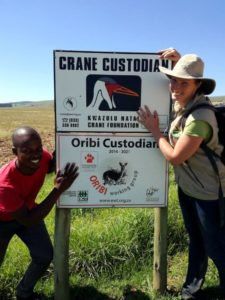
Nduduzo Khoza (EWT Eco-Ranger) and Twané Clarke (Karkloof Conservancy) excited to see these custodianship signs.
Custodians are landowners who are formally recognised by the Endangered Wildlife Trust (EWT) for their voluntary contribution to the conservation of threatened species on their farms, such as crane, oribi or blue swallows. (Download “Guidelines for Custodianship in SA” here)
By tea time, we had traversed the Shafton wetland and reached the Karkloof River bridge which crosses over the road to Cramond.
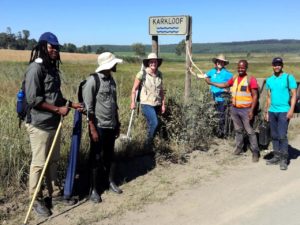
Karkloof River bridge along the Cramond road. From left: Ayanda Lipheyana (GroundTruth), Mbuso Khambule (Sappi), Twané Clarke (Karkloof Conservancy), Sue Viljoen (WWF-SA), Nduduzo Khoza (EWT Eco-Ranger) and Mondli Goba (Sappi)
Mbuso reminded us of the extent of SAPPI plantations that had been removed from the Shafton wetland a number of years ago and allowed to rehabilitate back to natural vegetation – some 186 ha were not replanted due to the existence of this important wetland system.
The next section of the river was slow moving, noticeably poorer in water quality and showed signs of being at the bottom of the valley’s catchment area, which ultimately receives all the nutrient rich runoff from the various activities along the way. The water colour had changed to a more murky greenish colour, there was a type of sludge on the rocks, in some quieter corners, traces of foam was seen on the surface and the sewage weed could be seen in many places along the river’s edge.
At the first set of large, impressive rocks above the falls, we did a Mini-SASS test, which showed the water was “critically modified”, confirming our impressions that the river’s quality was now compromised. At this site, a dead bushbuck was found between the large rocks, leaving us wondering what happened here. It looks like it lost its footing while trying to have a drink.
The condition of riverine buffer along this last stretch was also compromised due to high levels of alien invasive vegetation (such as the big clump of bamboo shown below, poplar saplings, elderflower and all the other commonly seen invasives we had seen higher up in the catchment). Pastures were unfortunately established very close to the river, and therefore without a wide section of natural vegetation to act as buffer and filter for the runoff, the river is all the more impacted.
Having followed every twist and turn of the river now for 5 days, we felt a certain sadness at the deterioration of the river’s health. However, the sight of the picnic site for the Karkloof falls picked up our spirits. Destination at last! Hooray for being able to pull off our boots and take a break in the shade! Here we were spoilt with orange ice-lollies by our videographer, Jayne Symes, who is putting a video clip together of the river walk. What a welcome gift! Thank you Jane!
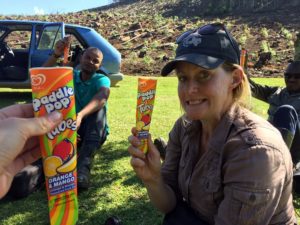
Jane Symes (Black & White Studios) was our hero that day. These ice cold treats were welcomed after a day of scorching heat and little shade.
While catching our breath over lunch, we chatted at length about the problem of litter at a public picnic site like this, and how increasingly popular the Karkloof Falls had become. Would new signage saying “litter free zone” and removing the dustbins help to change people’s behaviour so that all rubbish is taken away by visitors?
There was just 1 section left to walk down to the actual Karkloof falls viewing point and lower picnic site, our end point for the day. We said “bye for now” to the river, with the very last leg of the river’s journey to be continued the following Thursday, 6th April. A team photo in front of the falls was a fitting way to exclaim “WE MADE IT!”.

